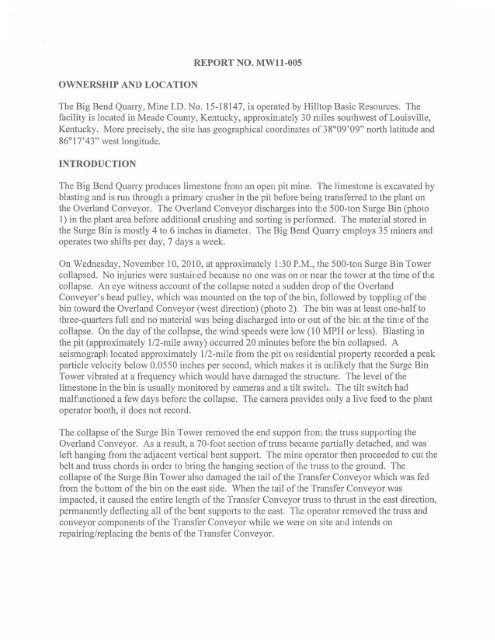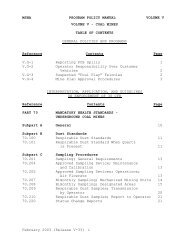Technical Support Report of Surge Bin Tower - Mine Safety and ...
Technical Support Report of Surge Bin Tower - Mine Safety and ...
Technical Support Report of Surge Bin Tower - Mine Safety and ...
Create successful ePaper yourself
Turn your PDF publications into a flip-book with our unique Google optimized e-Paper software.
OWNERSHIP AND LOCATION<br />
REPORT NO. MWII-00S<br />
The Big Bend Quarry, <strong>Mine</strong> 1.0. No. 15-18147, is operated by Hilltop Basic Resources. The<br />
facil ity is located in Meade County, Kentucky, approximately 30 mi les southwest <strong>of</strong> Louisville,<br />
Kentucky. More precisely, the site has geographical coordinates 0[38°09'09" north latitude <strong>and</strong><br />
86°17'43" west longitude.<br />
INTRODUCTION<br />
The Big Bend Quany produces limestone from an open pit minc. The limestone is excavated by<br />
blasting <strong>and</strong> is run through a primary crusher in the pit before being transferred to the plant on<br />
the Overl<strong>and</strong> Conveyor. The Overl<strong>and</strong> Conveyor discharges into the 500-ton <strong>Surge</strong> <strong>Bin</strong> (photo<br />
1) in the plant area before additional crushing <strong>and</strong> sorting is pClformed. The material stored in<br />
the <strong>Surge</strong> <strong>Bin</strong> is mostly 4 to 6 inches in diameter, The Big Bend Quan·y employs 35 miners <strong>and</strong><br />
operates two shifts per day, 7 days a week.<br />
On Wednesday. November 10, 2010, at approximately 1:30 P.M., the 500-ton <strong>Surge</strong> <strong>Bin</strong> <strong>Tower</strong><br />
coll apsed. No injuries were sustained because no one was on or near the tower at the time <strong>of</strong> the<br />
collapse. An cye witness account <strong>of</strong> the collapse noted a sudden drop <strong>of</strong> the Overl<strong>and</strong><br />
Conveyor' s head pulley, which was mounted on the top <strong>of</strong> the bin, followed by toppling <strong>of</strong> the<br />
bin toward the Overl<strong>and</strong> Conveyor (west direction) (photo 2). The bin was at least one-half to<br />
three-quarters full <strong>and</strong> no material was being discharged into or out <strong>of</strong> the bin at the time <strong>of</strong> the<br />
collapse. On the day <strong>of</strong> the collapse, the wind speeds were low (10 MPH or less). Blasting in<br />
the pit (approximately II2-mile away) occurred 20 minutes before the bin collapsed. A<br />
seismograph located approximately II2-mile from the pit on residential property recorded a peak<br />
particle velocity below 0.0550 inches per second, which makes it is unlikely that the <strong>Surge</strong> <strong>Bin</strong><br />
<strong>Tower</strong> vibrated at a frequency which would have damaged the structure. The level <strong>of</strong> the<br />
limestone in the bin is usually monitored by cameras <strong>and</strong> a tilt switch. The tilt switch had<br />
malfunctioned a few days before the collapse. The camera provides only a live feed to the plant<br />
operator booth, it does not record.<br />
The collapse <strong>of</strong> the <strong>Surge</strong> <strong>Bin</strong> <strong>Tower</strong> removed the end support from the truss supporting the<br />
Overl<strong>and</strong> Conveyor. As a result. a 70-foot section <strong>of</strong> truss became partially detached, <strong>and</strong> was<br />
left hanging from the adjacent vertical bent support. The mine operator then proceeded to cut the<br />
belt <strong>and</strong> truss chords in order to bring the hanging section <strong>of</strong> the truss to the ground. The<br />
collapse <strong>of</strong> the <strong>Surge</strong> <strong>Bin</strong> <strong>Tower</strong> also damaged the tail <strong>of</strong> the Transfer Conveyor which was fed<br />
from the bottom <strong>of</strong> the bin on the east side. When the tail <strong>of</strong> the Transfer Conveyor was<br />
impacted, it caused the entire length <strong>of</strong> the Transfer Conveyor truss to thrust in the east direction,<br />
pennanently deflecting all <strong>of</strong> the bent supports to the east. The operator removed the truss <strong>and</strong><br />
conveyor components <strong>of</strong> the Transfer Conveyor while we were on site <strong>and</strong> intends on<br />
repairing/replacing the bents <strong>of</strong> the Transfer Conveyor.

















